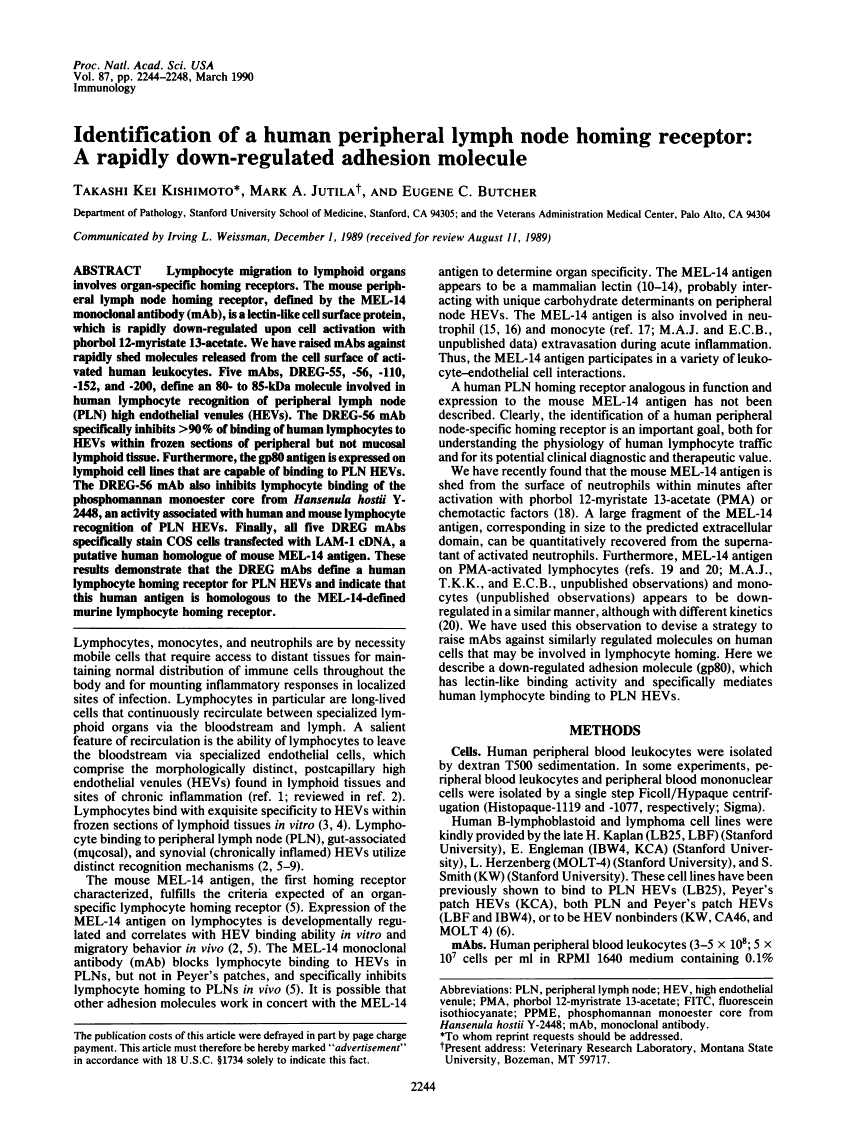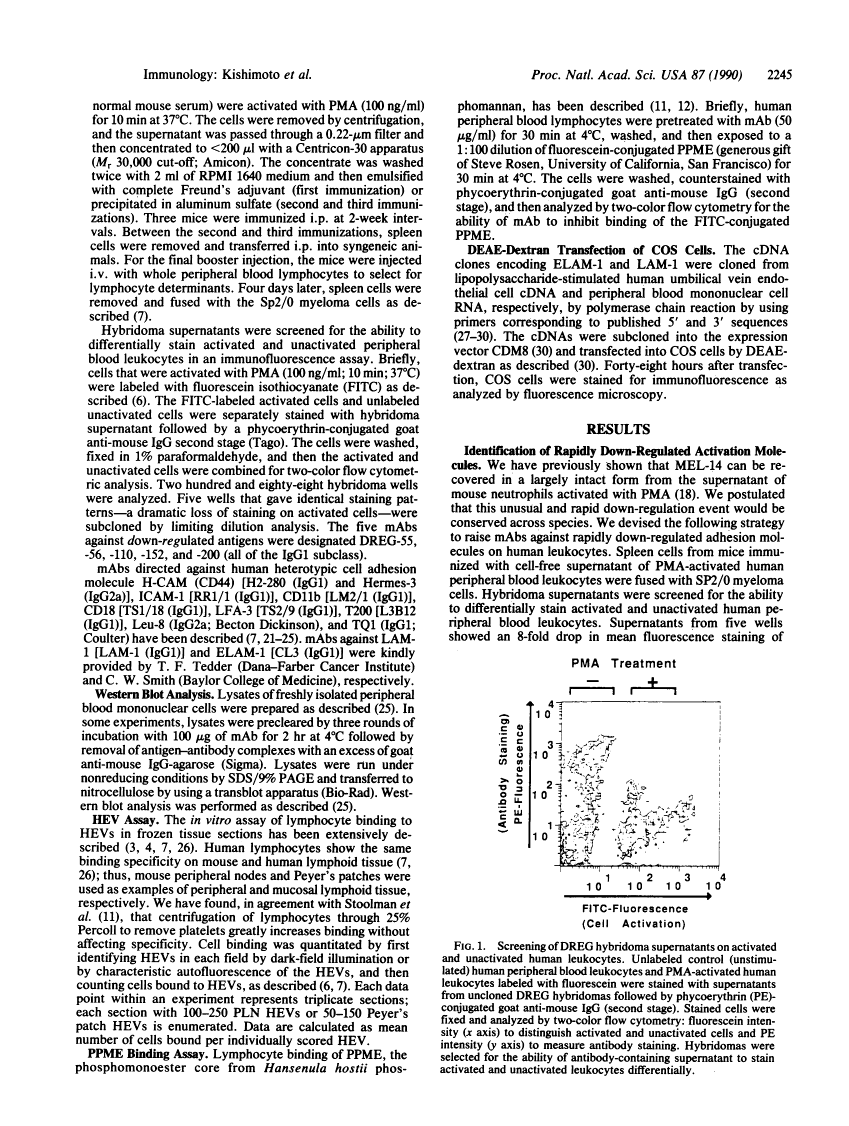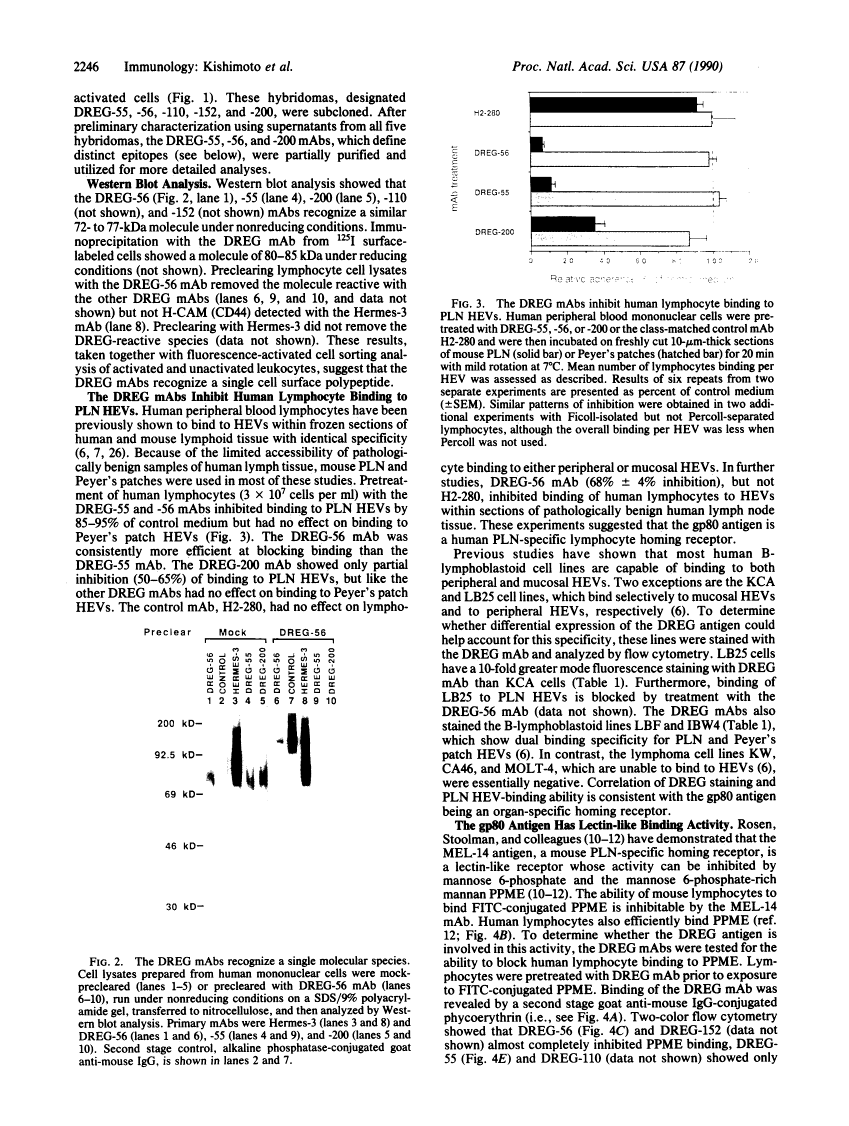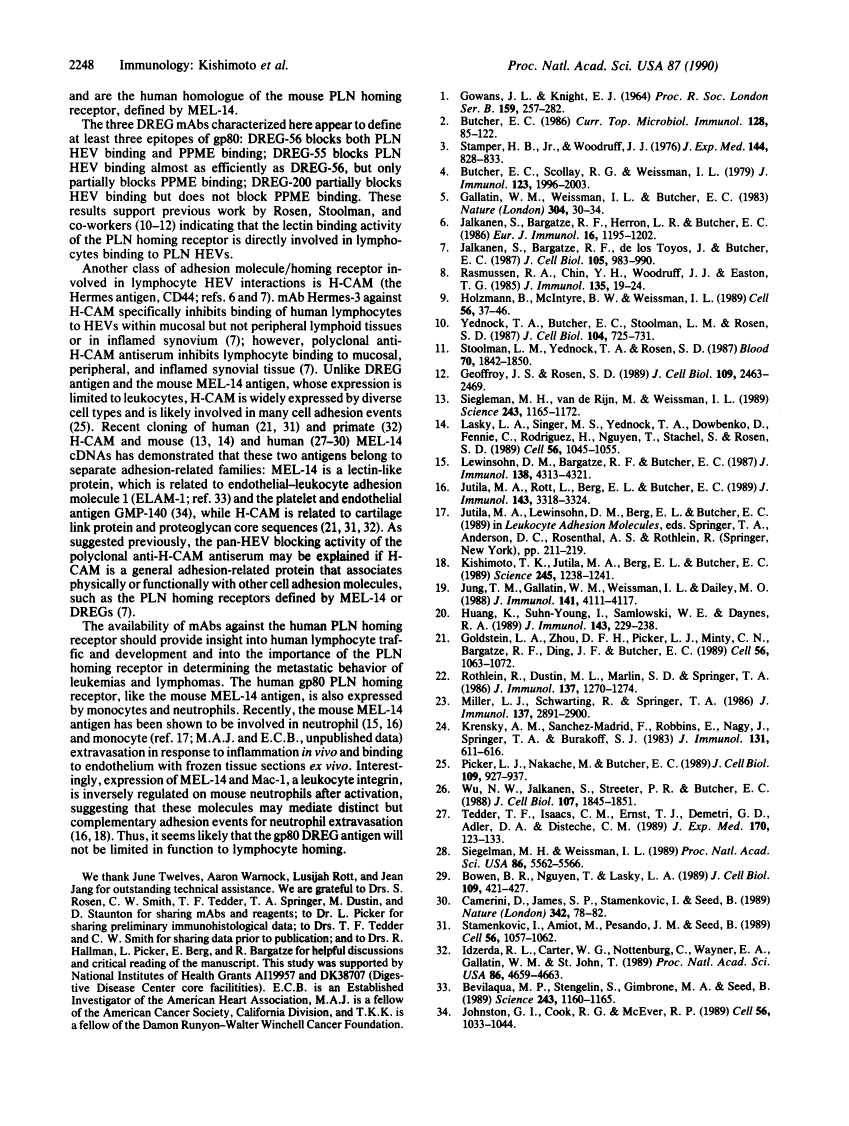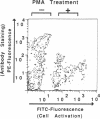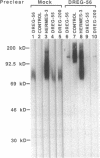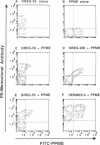Abstract
Free full text

Identification of a human peripheral lymph node homing receptor: a rapidly down-regulated adhesion molecule.
Abstract
Lymphocyte migration to lymphoid organs involves organ-specific homing receptors. The mouse peripheral lymph node homing receptor, defined by the MEL-14 monoclonal antibody (mAb), is a lectin-like cell surface protein, which is rapidly down-regulated upon cell activation with phorbol 12-myristate 13-acetate. We have raised mAbs against rapidly shed molecules released from the cell surface of activated human leukocytes. Five mAbs, DREG-55, -56, -110, -152, and -200, define an 80- to 85-kDa molecule involved in human lymphocyte recognition of peripheral lymph node (PLN) high endothelial venules (HEVs). The DREG-56 mAb specifically inhibits greater than 90% of binding of human lymphocytes to HEVs within frozen sections of peripheral but not mucosal lymphoid tissue. Furthermore, the gp80 antigen is expressed on lymphoid cell lines that are capable of binding to PLN HEVs. The DREG-56 mAb also inhibits lymphocyte binding of the phosphomannan monoester core from Hansenula hostii Y-2448, an activity associated with human and mouse lymphocyte recognition of PLN HEVs. Finally, all five DREG mAbs specifically stain COS cells transfected with LAM-1 cDNA, a putative human homologue of mouse MEL-14 antigen. These results demonstrate that the DREG mAbs define a human lymphocyte homing receptor for PLN HEVs and indicate that this human antigen is homologous to the MEL-14-defined murine lymphocyte homing receptor.
Full text
Full text is available as a scanned copy of the original print version. Get a printable copy (PDF file) of the complete article (1.3M), or click on a page image below to browse page by page. Links to PubMed are also available for Selected References.
Images in this article
Click on the image to see a larger version.
Selected References
These references are in PubMed. This may not be the complete list of references from this article.
- GOWANS JL, KNIGHT EJ. THE ROUTE OF RE-CIRCULATION OF LYMPHOCYTES IN THE RAT. Proc R Soc Lond B Biol Sci. 1964 Jan 14;159:257–282. [Abstract] [Google Scholar]
- Butcher EC. The regulation of lymphocyte traffic. Curr Top Microbiol Immunol. 1986;128:85–122. [Abstract] [Google Scholar]
- Stamper HB, Jr, Woodruff JJ. Lymphocyte homing into lymph nodes: in vitro demonstration of the selective affinity of recirculating lymphocytes for high-endothelial venules. J Exp Med. 1976 Sep 1;144(3):828–833. [Europe PMC free article] [Abstract] [Google Scholar]
- Butcher EC, Scollay RG, Weissman IL. Lymphocyte adherence to high endothelial venules: characterization of a modified in vitro assay, and examination of the binding of syngeneic and allogeneic lymphocyte populations. J Immunol. 1979 Nov;123(5):1996–2003. [Abstract] [Google Scholar]
- Gallatin WM, Weissman IL, Butcher EC. A cell-surface molecule involved in organ-specific homing of lymphocytes. Nature. 1983 Jul 7;304(5921):30–34. [Abstract] [Google Scholar]
- Jalkanen ST, Bargatze RF, Herron LR, Butcher EC. A lymphoid cell surface glycoprotein involved in endothelial cell recognition and lymphocyte homing in man. Eur J Immunol. 1986 Oct;16(10):1195–1202. [Abstract] [Google Scholar]
- Jalkanen S, Bargatze RF, de los Toyos J, Butcher EC. Lymphocyte recognition of high endothelium: antibodies to distinct epitopes of an 85-95-kD glycoprotein antigen differentially inhibit lymphocyte binding to lymph node, mucosal, or synovial endothelial cells. J Cell Biol. 1987 Aug;105(2):983–990. [Europe PMC free article] [Abstract] [Google Scholar]
- Rasmussen RA, Chin YH, Woodruff JJ, Easton TG. Lymphocyte recognition of lymph node high endothelium. VII. Cell surface proteins involved in adhesion defined by monoclonal anti-HEBFLN (A.11) antibody. J Immunol. 1985 Jul;135(1):19–24. [Abstract] [Google Scholar]
- Holzmann B, McIntyre BW, Weissman IL. Identification of a murine Peyer's patch--specific lymphocyte homing receptor as an integrin molecule with an alpha chain homologous to human VLA-4 alpha. Cell. 1989 Jan 13;56(1):37–46. [Abstract] [Google Scholar]
- Yednock TA, Butcher EC, Stoolman LM, Rosen SD. Receptors involved in lymphocyte homing: relationship between a carbohydrate-binding receptor and the MEL-14 antigen. J Cell Biol. 1987 Mar;104(3):725–731. [Europe PMC free article] [Abstract] [Google Scholar]
- Stoolman LM, Yednock TA, Rosen SD. Homing receptors on human and rodent lymphocytes--evidence for a conserved carbohydrate-binding specificity. Blood. 1987 Dec;70(6):1842–1850. [Abstract] [Google Scholar]
- Geoffroy JS, Rosen SD. Demonstration that a lectin-like receptor (gp90MEL) directly mediates adhesion of lymphocytes to high endothelial venules of lymph nodes. J Cell Biol. 1989 Nov;109(5):2463–2469. [Europe PMC free article] [Abstract] [Google Scholar]
- Siegelman MH, van de Rijn M, Weissman IL. Mouse lymph node homing receptor cDNA clone encodes a glycoprotein revealing tandem interaction domains. Science. 1989 Mar 3;243(4895):1165–1172. [Abstract] [Google Scholar]
- Lasky LA, Singer MS, Yednock TA, Dowbenko D, Fennie C, Rodriguez H, Nguyen T, Stachel S, Rosen SD. Cloning of a lymphocyte homing receptor reveals a lectin domain. Cell. 1989 Mar 24;56(6):1045–1055. [Abstract] [Google Scholar]
- Lewinsohn DM, Bargatze RF, Butcher EC. Leukocyte-endothelial cell recognition: evidence of a common molecular mechanism shared by neutrophils, lymphocytes, and other leukocytes. J Immunol. 1987 Jun 15;138(12):4313–4321. [Abstract] [Google Scholar]
- Jutila MA, Rott L, Berg EL, Butcher EC. Function and regulation of the neutrophil MEL-14 antigen in vivo: comparison with LFA-1 and MAC-1. J Immunol. 1989 Nov 15;143(10):3318–3324. [Abstract] [Google Scholar]
- Kishimoto TK, Jutila MA, Berg EL, Butcher EC. Neutrophil Mac-1 and MEL-14 adhesion proteins inversely regulated by chemotactic factors. Science. 1989 Sep 15;245(4923):1238–1241. [Abstract] [Google Scholar]
- Jung TM, Gallatin WM, Weissman IL, Dailey MO. Down-regulation of homing receptors after T cell activation. J Immunol. 1988 Dec 15;141(12):4110–4117. [Abstract] [Google Scholar]
- Huang K, Im SY, Samlowski WE, Daynes RA. Molecular mechanisms of lymphocyte extravasation. III. The loss of lymphocyte extravasation potential induced by pertussis toxin is not mediated via the activation of protein kinase C. J Immunol. 1989 Jul 1;143(1):229–238. [Abstract] [Google Scholar]
- Goldstein LA, Zhou DF, Picker LJ, Minty CN, Bargatze RF, Ding JF, Butcher EC. A human lymphocyte homing receptor, the hermes antigen, is related to cartilage proteoglycan core and link proteins. Cell. 1989 Mar 24;56(6):1063–1072. [Abstract] [Google Scholar]
- Rothlein R, Dustin ML, Marlin SD, Springer TA. A human intercellular adhesion molecule (ICAM-1) distinct from LFA-1. J Immunol. 1986 Aug 15;137(4):1270–1274. [Abstract] [Google Scholar]
- Miller LJ, Schwarting R, Springer TA. Regulated expression of the Mac-1, LFA-1, p150,95 glycoprotein family during leukocyte differentiation. J Immunol. 1986 Nov 1;137(9):2891–2900. [Abstract] [Google Scholar]
- Krensky AM, Sanchez-Madrid F, Robbins E, Nagy JA, Springer TA, Burakoff SJ. The functional significance, distribution, and structure of LFA-1, LFA-2, and LFA-3: cell surface antigens associated with CTL-target interactions. J Immunol. 1983 Aug;131(2):611–616. [Abstract] [Google Scholar]
- Picker LJ, Nakache M, Butcher EC. Monoclonal antibodies to human lymphocyte homing receptors define a novel class of adhesion molecules on diverse cell types. J Cell Biol. 1989 Aug;109(2):927–937. [Europe PMC free article] [Abstract] [Google Scholar]
- Wu NW, Jalkanen S, Streeter PR, Butcher EC. Evolutionary conservation of tissue-specific lymphocyte-endothelial cell recognition mechanisms involved in lymphocyte homing. J Cell Biol. 1988 Nov;107(5):1845–1851. [Europe PMC free article] [Abstract] [Google Scholar]
- Tedder TF, Isaacs CM, Ernst TJ, Demetri GD, Adler DA, Disteche CM. Isolation and chromosomal localization of cDNAs encoding a novel human lymphocyte cell surface molecule, LAM-1. Homology with the mouse lymphocyte homing receptor and other human adhesion proteins. J Exp Med. 1989 Jul 1;170(1):123–133. [Europe PMC free article] [Abstract] [Google Scholar]
- Siegelman MH, Weissman IL. Human homologue of mouse lymph node homing receptor: evolutionary conservation at tandem cell interaction domains. Proc Natl Acad Sci U S A. 1989 Jul;86(14):5562–5566. [Europe PMC free article] [Abstract] [Google Scholar]
- Bowen BR, Nguyen T, Lasky LA. Characterization of a human homologue of the murine peripheral lymph node homing receptor. J Cell Biol. 1989 Jul;109(1):421–427. [Europe PMC free article] [Abstract] [Google Scholar]
- Camerini D, James SP, Stamenkovic I, Seed B. Leu-8/TQ1 is the human equivalent of the Mel-14 lymph node homing receptor. Nature. 1989 Nov 2;342(6245):78–82. [Abstract] [Google Scholar]
- Stamenkovic I, Amiot M, Pesando JM, Seed B. A lymphocyte molecule implicated in lymph node homing is a member of the cartilage link protein family. Cell. 1989 Mar 24;56(6):1057–1062. [Abstract] [Google Scholar]
- Idzerda RL, Carter WG, Nottenburg C, Wayner EA, Gallatin WM, St John T. Isolation and DNA sequence of a cDNA clone encoding a lymphocyte adhesion receptor for high endothelium. Proc Natl Acad Sci U S A. 1989 Jun;86(12):4659–4663. [Europe PMC free article] [Abstract] [Google Scholar]
- Bevilacqua MP, Stengelin S, Gimbrone MA, Jr, Seed B. Endothelial leukocyte adhesion molecule 1: an inducible receptor for neutrophils related to complement regulatory proteins and lectins. Science. 1989 Mar 3;243(4895):1160–1165. [Abstract] [Google Scholar]
- Johnston GI, Cook RG, McEver RP. Cloning of GMP-140, a granule membrane protein of platelets and endothelium: sequence similarity to proteins involved in cell adhesion and inflammation. Cell. 1989 Mar 24;56(6):1033–1044. [Abstract] [Google Scholar]
Associated Data
Articles from Proceedings of the National Academy of Sciences of the United States of America are provided here courtesy of National Academy of Sciences
Full text links
Read article at publisher's site: https://doi.org/10.1073/pnas.87.6.2244
Read article for free, from open access legal sources, via Unpaywall:
https://europepmc.org/articles/pmc53663?pdf=render
Citations & impact
Impact metrics
Article citations
A Designed Host Defense Peptide for the Topical Treatment of MRSA-Infected Diabetic Wounds.
Int J Mol Sci, 24(3):2143, 21 Jan 2023
Cited by: 0 articles | PMID: 36768463 | PMCID: PMC9917076
Activation of ADAM17 by IL-15 Limits Human NK Cell Proliferation.
Front Immunol, 12:711621, 22 Jul 2021
Cited by: 13 articles | PMID: 34367174 | PMCID: PMC8339566
Anti-Ly6G binding and trafficking mediate positive neutrophil selection to unleash the anti-tumor efficacy of radiation therapy.
Oncoimmunology, 10(1):1876597, 08 Feb 2021
Cited by: 10 articles | PMID: 33628622 | PMCID: PMC7889163
Ectodomain shedding by ADAM17 (a disintegrin and metalloproteinase 17) in canine neutrophils.
Vet Immunol Immunopathol, 231:110162, 17 Nov 2020
Cited by: 4 articles | PMID: 33264689 | PMCID: PMC7769933
Fecal Microbiota Transplantation: A Potential Tool for Treatment of Human Female Reproductive Tract Diseases.
Front Immunol, 10:2653, 26 Nov 2019
Cited by: 47 articles | PMID: 31827467 | PMCID: PMC6890827
Review Free full text in Europe PMC
Go to all (235) article citations
Protocols & materials
Similar Articles
To arrive at the top five similar articles we use a word-weighted algorithm to compare words from the Title and Abstract of each citation.
The Mel 14 antibody binds to the lectin domain of the murine peripheral lymph node homing receptor.
J Cell Biol, 110(1):147-153, 01 Jan 1990
Cited by: 46 articles | PMID: 1688560 | PMCID: PMC2115993
Regulation and lectin activity of the human neutrophil peripheral lymph node homing receptor.
Blood, 76(1):178-183, 01 Jul 1990
Cited by: 37 articles | PMID: 2194589
Differential expression of homing-associated adhesion molecules by T cell subsets in man.
J Immunol, 145(10):3247-3255, 01 Nov 1990
Cited by: 150 articles | PMID: 1700003
Human lymphocyte and lymphoma homing receptors.
Annu Rev Med, 38:467-476, 01 Jan 1987
Cited by: 24 articles | PMID: 3555307
Review
Funding
Funders who supported this work.
NIAID NIH HHS (1)
Grant ID: AI19957
NIDDK NIH HHS (1)
Grant ID: DK38707
